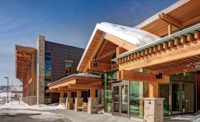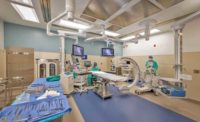Owner U.S. Dept. of Veterans Affairs
Lead Design Firm Studio Nova LP (NBBJ as Lead Designer With EDR and Rozas Ward as Architectural Participants)
General Contractor Clark/McCarthy Healthcare Partners
Civil Engineer Schrenk & Peterson Consulting Engineers Inc.
Structural Engineer Korda/Nemeth Engineering
MEP Engineer Bard, Rao + Athanas Consulting Engineers LLC
It would have been enough to reimagine and build what a U.S. Dept. of Veterans Affairs hospital should be from the ground up. It would have been a notable accomplishment to build a resilient facility that could function in nearly 20 ft of flood water for up to a week. And it would have been an achievement to build a 1.6- million-sq-ft structure within a tight urban setting. “The goal was for the facility to feel like an extension of the urban fabric of New Orleans, with ample access to daylight and views,” says Ryan Hullinger, a partner at NBBJ. The new $1-billion VA hospital in New Orleans, dubbed “Project Legacy,” did all of these things and more—using more than 200 subcontractors and logging in 8.45 million worker hours over its five-year construction period. “Attention to veterans’ needs, resiliency issues specific to New Orleans and local conditions contributed to a design that appears to have met many challenges, all while meeting federal standards,” one judge commented. The buildings, on a 31-acre campus, will serve up to 550,000 veterans each year across the Gulf Coast. The design team met with staff and veterans to develop a project vision to best serve users. For instance, after learning that many patients travel more than one hour to reach the hospital, designers located bathrooms in the parking garage. With lessons of Hurricane Katrina in mind, the facility has a sacrificial first floor designed to be flooded. The emergency room and essential utilities are above the 20-ft base flood elevation and accessible by an ambulance bay elevated 19 ft that can double as a boat dock. While not originally planned, the Clark/McCarthy team handed over buildings as they were completed. “In the end,” says Chip Hastie, Clark executive vice president, “we were able to initiate patient care as early as possible and became a model for activation planning at other major facilities around the country.”






Post a comment to this article
Report Abusive Comment